
Causes of Social Anxiety
When social anxiety is persistent and pervasive it can lead to a diagnosis of social anxiety disorder, a disabling condition that makes social interactions of all types stressful and challenging. Social anxiety disorder emerges from a confluence of factors, including genetic predisposition, childhood experiences, and unusual brain functioning. Despite the difficulties social anxiety creates for sufferers, it is highly responsive to treatment and its symptoms can be effectively managed.
Defining Social Anxiety and Social Anxiety Disorder
Social anxiety can profoundly affect someone’s ability to socialize and communicate with other people. For those suffering from full-blown social anxiety disorder, which in any given year includes up to seven percent of the adult population, the symptoms of social anxiety can be overwhelming, debilitating, and beyond their ability to control.
The defining characteristics of social anxiety include:
* Intense fear of social interactions in a wide variety of contexts
* Anticipatory anxiety that leads social anxiety sufferers to avoid opportunities for conversation or public speaking
* Extreme symptoms of anxiety experienced during unwanted or stressful social interactions
* Poor verbal communication skills, complicated by a person’s inability to think clearly while experiencing anxiety
* Overly critical self-evaluations of performance after conversations or spoken presentations are finished
* Low self-esteem and a lack of self-confidence, which are reinforced by constant self-criticism
When not interacting with close friends or family, people with severe social anxiety have a deep-seated fear of being judged, rejected, embarrassed or humiliated during social interactions. As irrational as those fears may be, they are difficult to escape.
Genetic Causes of Social Anxiety Disorder
People with a parent or parents who’ve suffered from social anxiety disorder have a 30-40 percent greater likelihood of developing the condition themselves. However, it is impossible to know how much of the parent-child social anxiety association is based on genetics and how much is based on parenting style, which is naturally affected by the presence of the disorder.
Recent research into specific genetic markers for social anxiety have focused on changes in a gene called SLCGA4, which is involved in the transport of the neurotransmitter serotonin, a chemical that can help soothe nerves and stabilize moods. Both shortages and excesses of serotonin have been linked to social anxiety symptoms, and people with social anxiety disorder struggle to produce serotonin consistently and without fluctuation.
Aberrations in the performance of the gene SLCGA4 appear to be linked to this problem, and these faulty genes can be passed from parents to children.
Social Anxiety Disorder and the Brain
Brain scans have revealed that people with social anxiety disorder suffer from hyperactivity in a part of the brain known as the amygdala. The amygdala is responsible for the physiological changes associated with the “flight-or-fight” response, which mobilizes the body to respond to perceived threats, real or imagined.
Action in the amygdala triggers an avalanche of symptoms identified with intense anxiety, including rapid heartbeat, sweaty palms, respiratory excitement, muscle tightening, a surge in blood sugar levels, and a freezing of the brain that leaves anxiety sufferers unable to think or reason normally.
When people experience a surge of anxiety, mental focus shifts to a part of the brain called the prefrontal cortex. It is the job of the prefrontal cortex to calm those reactions by assessing them rationally and calmly, and if no real threat is present it is supposed to send signals to the amygdala that defuse its anxious response.
But in social anxiety sufferers, the prefrontal cortex actually amplifies the activity of the amygdala instead of calming it. People with social anxiety have such an entrenched fear of other peoples’ reactions that their brains interpret social interactions as legitimate threats, and no amount of rational reflection can completely soothe those fears.
Fortunately, brains can be reprogrammed to form new circuits and connections at any age. With the help of cognitive-behavioral therapy (the preferred form of therapy for social anxiety), people with social anxiety disorder can retrain their brains to react more rationally and reflectively during social encounters that hold no real danger.

The Effect of Parenting Styles on Social Anxiety
Extensive research has confirmed a connection between negative parenting styles and anxiety disorders, including social anxiety disorder.
When parents are overcontrolling, quick to criticize, reluctant to show affection, or overly concerned with the opinions of others, a child’s self-image and impression of the world can be shaped by words and actions associated with these characteristics.
Children and adolescents may become more fearful and less trustful of other people when they are raised in this environment, and their self-esteem and self-confidence may be negatively impacted as well. In these instances, parents don’t realize their actions are harmful, but their focus on the negative inadvertently can set their children up for trouble later in life.
Social anxiety disorder is usually not diagnosed until sufferers reach adulthood, but symptoms tend to first manifest in late childhood or early adolescence, which bolsters the idea that parental influences are playing a formational role in the development of the disorder.
Environmental Influences and Stressful Life Experiences as a Cause of Social Anxiety
Stressful life events and trauma during childhood can influence the development of social anxiety problems. Some of the exposures known to have predictive value for severe social anxiety include:
- Physical, sexual, or emotional abuse
- Bullying or teasing by peers
- Family conflicts, domestic violence, and divorce
- Death of or desertion by a parent
- Maternal stress during pregnancy or infancy
Traumatic experiences can reinforce the idea that the world is a scary and unpredictable place, and it can be especially shocking and disheartening to kids to discover that their caregivers are capable of selfish or hurtful behavior.
Begin Your Recovery Journey.
877-727-4343Social Anxiety Triggers
People suffering from social anxiety do not experience its symptoms in every social situation.
When they have interactions with people they know well or are certain they can trust—partners, parents, siblings, children, grandparents, close friends, long-time employers, favorite teachers, etc.—they may show no signs of social anxiety whatsoever. And if they’re asked to speak in public about subjects where they have expertise or a record of accomplishment, they may be able to do so with some degree of confidence.
But many other situations evoke great distress and anxiety, even though they wouldn’t seem threatening to most other people. Some of the common triggers for social anxiety sufferers include:
- Meeting new people
- Dating
- Interactions with authority figures
- Conversations with extroverts
- Parties, especially if the social anxiety sufferer is attending alone
- Large family gatherings where not everyone is familiar
- Unexpected attempts to initiate conversations by others in public places (e.g., standing in line at the bank or grocery store)
- Being teased or kidded (people with social anxiety disorder tend to take teasing personally)
- Being watched while performing a new or unfamiliar task
- Being asked to speak in front of a class or a roomful of co-workers
- Speaking on the phone, especially with strangers
- Therapy sessions or support groups for social anxiety (it can sometimes be difficult for social anxiety sufferers to open up and discuss their feelings honestly in such settings)
Most people with social anxiety disorder have three or four situations that cause overwhelmingly anxious reactions, and they will go to great lengths to avoid these exposures if they possibly can. Other social situations may produce more moderate anxiety symptoms, but even these are unpleasant and make life more difficult than it should be.
Finding Help for Social Anxiety Disorder
Undiagnosed and untreated social anxiety disorder is a devastating condition that can severely limit daily functioning. Even when social anxiety sufferers realize they have a serious problem they may have difficulty asking for help, since therapists are authority figures and people with social anxiety disorder generally avoid interactions with authority figures if they can.
But treatment for social anxiety disorder is highly effective, and when sufferers do summon the courage to ask for help they often achieve terrific results, both short-term and long-term.
While antidepressants and anti-anxiety medications are often prescribed for people with social anxiety disorder, psychotherapy is the core of social anxiety treatment. Cognitive-behavioral therapy (CBT) in particular has been found to be effective against social anxiety’s most disabling symptoms, and is almost always recommended by mental health professionals who see social anxiety disorder patients.
Most treatment for social anxiety takes place on an outpatient basis. But people who’ve struggled with social anxiety disorder for many years can gain great benefit from inpatient stay in a mental health treatment facility, where all the focus is on recovery.
In residential treatment programs, CBT and other essential services will be offered in a compassionate, patient-centered environment. Peer interactions are usually included in residential social anxiety disorder recovery programs, giving social anxiety sufferers a unique and important opportunity to connect with others who face similar life challenges and understand the difficulties of overcoming them.
Social anxiety disorder is difficult to endure, but with the help of treatment services and mental health professionals its symptoms are manageable. Even though social anxiety sufferers sometimes have trouble asking for help, once they do they never regret it.





